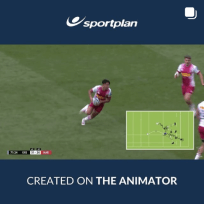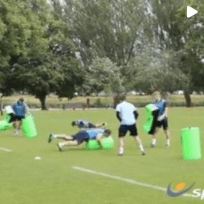
We are setting up 4 contact areas where 4 rucks will be formed. We have 4 pairs of defencive players (with or without rucking shields) on the far line of cones. we have 4 ball carriers on the middle line of cones. we have 2 sets of 3 support players on the first 2 cones on the near line. when the ball is passed to the first ball carrier he drives into the pair of defencive players in front of him the 1st set of support players then go to support and secure the ball once the ball is passed the support players have to get to the yellow cone ready to support the 3rd ball carrier once the ball is secured it is passed to the 2nd ball carrier who drives into the pair of defencive players in front of him So the 1st set of support players have to support the 1st ball carrier and then the 3th ball carrier The 2nd set of support players have to support the 2nd ball carrier and then the 4th ball carrier
The ball carrier needs to stay on there feet as long as possible, until the support players arrive. The ball carrier need to sucure the ball and present in back as far as possible as quickly as possible, needs to continue working on the ground. Support Players need to react as fast, and get to the ball carrier. Support players need to communicate with the ball carrier to let him know what to do. Make sure the counter rucking players comes in low and drives up and over the ruck, body possition beats size every time.
This practice has no coaching points
This practice has no progressions

in more ways than one




Save yourself a scare this Halloween and ensure your session runs smoothly. No chaos, no fright, just structure.

As the Lions tour approaches with their first tour game this Friday against Argentina, we look ahead at what the fans can expect to see from both sides as the tour in Australia approaches...

Introducing the Sportplan FootballBot. Your new coaching partner that has all the answers to the questions you may have...